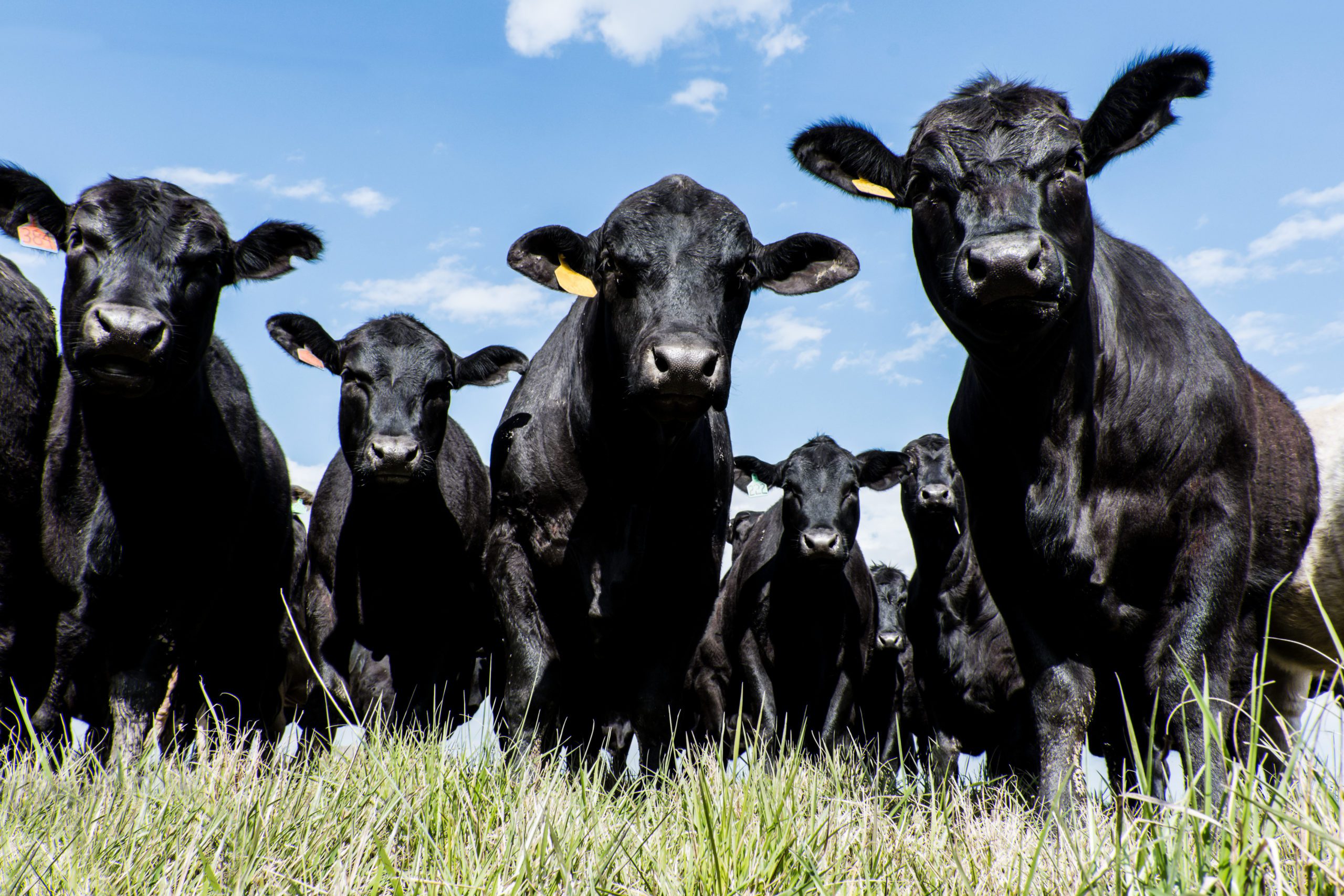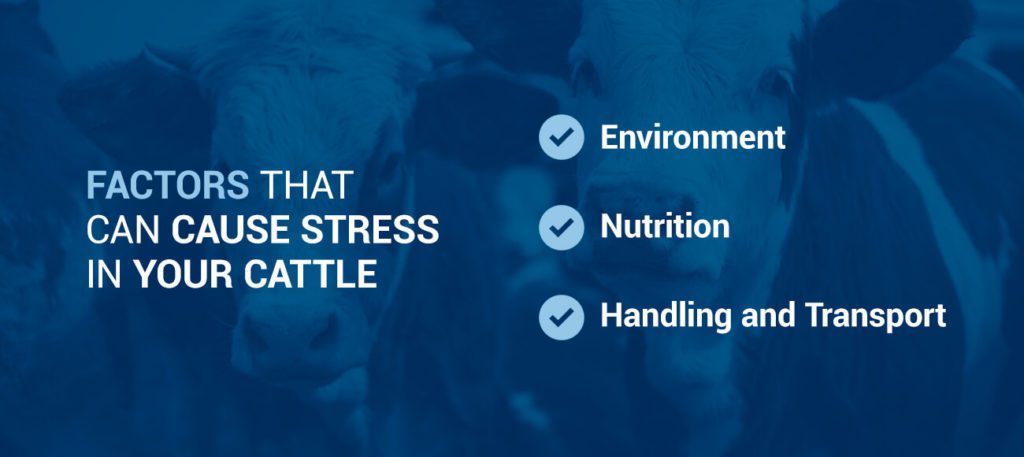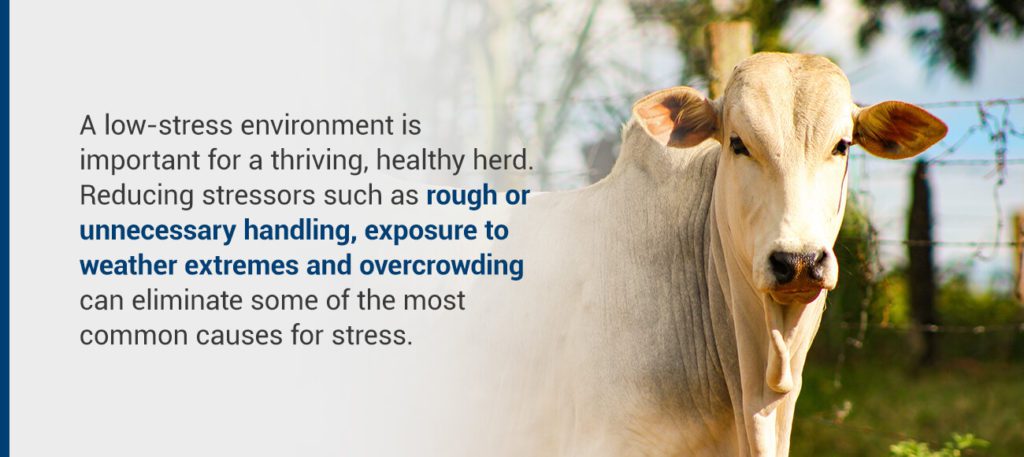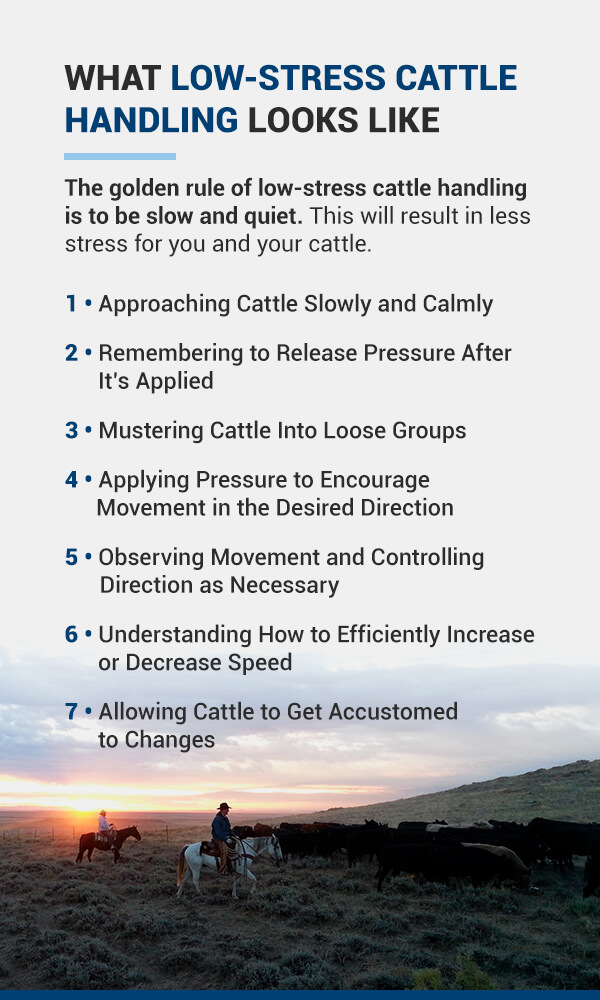
As a cattleman, you understand that the health of your cattle depends on many factors, including providing them with a safe, low-stress environment. If your cattle experience stress, then not only does every day become an uphill battle, but your cattle may experience illness and shrink, leading to lost production.
One of your greatest tools in combatting the effects of stress is a thorough understanding of cattle behavior and handling techniques. This may be the most important step in providing your cattle with a low-stress environment and increasing productivity.

Why Are My Cattle Stressed?
Cattle process and respond to stress differently than humans do. They may seem illogical, but as prey animals, they rely on their instincts to protect themselves. Here are three factors that can cause stress in your cattle:
- Environment: Cattle are prey. They are born to be on the lookout for predators — including humans. Their senses of hearing and sight are keenly aware of anything that could pose a danger. Loud noises, unfamiliar places and people entering their flight zone — the area that could trigger them to flee —are all things that can cause fear in your cattle. Since cattle will remember triggering events and places, they might also begin to associate fear with activities that should otherwise be stress-free.
- Nutrition: Believe it or not, nutrition can be a large source of physical stress for cattle. Inadequate availability can increase hostility amongst herd members and lead to social discord. In addition, the feed itself can create stress — concentrated feeds create an additional burden on the digestive system, leading to physical responses, such as increased acid production and a build-up of rumen gases.
- Handling and Transport: Moving cattle can be a difficult task. Whether they are being moved on foot or being moved via transport, they will experience a certain level of stress. Some handlers make the mistake of striking or yelling at cattle, assuming this will better guide them to the desired destination. This type of handling, however, triggers the flight or freeze response, causing excess cortisol release. With repeated rough handling, they will begin to associate humans with that negative experience — and they could become harder to move over time because they associate moving with danger.
Risks Associated With High Stress in Cattle
Everyone wants to avoid stress. Humans have the ability to manage and process stress because of their cognitive abilities. Cattle are unable to process stress as humans can, which can cause their stress levels to spiral out of control. Besides making your cattle difficult to manage and move, stress can have the following effects on your livestock:
- Inappetence: Your cattle may lose the desire to eat due to excess cortisol and the presence of elevated acid levels in the rumen. This affects health, weight gain and many other factors.
- Susceptibility to disease: Stress can cause an increased cortisol level in your cattle, suppressing the immune system and causing them to be more susceptible to the development of diseases and conditions such as SARA (sub-acute ruminal acidosis).
- Reduced productivity: Low productivity due to stress can result in low live weight gains, low conception rates, low milk yields, high pre-weaning mortality and increased susceptibility to diseases.
The negative results of cattle stress will increase over time if left unresolved. Your cattle will spend more of their mental and physical resources trying to navigate and deal with stressful situations. As a result, they will experience cortisol spikes, causing a loss of appetite. This affects their ability to fight diseases and maintain weight.
It’s a circular sequence of events, but one that can be broken. Keeping stress at a minimum is key to having a healthy, productive herd.

Facilities for Lowering Stress in Cattle
Your facilities have a direct influence on the stress level of your cattle. Cattle require predictable, non-threatening surroundings. Facilities should aid in their natural functions rather than create stress. Because of their acute hearing, noisy environments can distress them. Their wide but blurry field of vision can result in unfamiliar objects, acute angles, lights or shadows adding to their stress level. Cows also have depth perception deficits in comparison to humans, so they can become uneasy when faced with variations in terrain or housing facilities (i.e. the reason cattleguards work so well).
A low-stress environment for cattle is the key to a productive, functioning herd. Your facilities need to work with your cattle instead of against them. Your facilities should provide adequate shelter and protection for your cattle.
You need to be able to adequately contain cattle within your pens and create a layout that will allow for a natural flow from one area to another. Structure the layout of your cattle facilities to aid in movement through gates into other pens and pastures. Because cows have poor vision, they trust the cow in front of them to guide them during movement, making it imperative to make facilities that will not cause balking of the lead animals.
Cattle can eventually learn that routine care requirements, such as vaccinations, are nothing to be afraid of if there are no negative experiences attached to the activity. They can even associate the loud sound of an approaching tractor with feed, creating a positive response to the noise.
Every so often, you should walk around your facilities to see if there are any potential stressors that could be affecting your cattle. Here are some things to keep an eye out for:
- Unusual shadows on facility floors or “blind areas” in the pastures
- Wet spots on the floor
- Sharp corners
- Areas of darkness, such as in the chute
- Places with loud noises nearby
Try to limit these possible stressors and build your facilities to aid in the handling of your cattle.

What Low-Stress Cattle Handling Looks Like
The golden rule of low-stress cattle handling is to be slow and quiet. This will result in less likelihood of triggering a flight response in your cattle.
Approaching Cattle Slowly and Calmly
Cattle will instinctually move away from you when you approach them. When you enter an animal’s flight zone, you are applying pressure to them. If you approach too quickly or aggressively, they can be startled. When an animal bolts, it can be very difficult to control and may panic the other animals in the herd. It’s important to approach them slowly and calmly to help avoid causing distress.
Be aware when entering an animal’s flight zone. They will notice and look up at you to determine if you are a threat. At this point, you must make sure to be relaxed and calm. Avoid approaching an animal head-on, as this can be perceived as threatening. If you spend too long in an animal’s blind spot, which is the area directly behind them, they may become nervous. Approach your animal from the side, being mindful of pressure.
Remembering to Release Pressure After It’s Applied
When you apply pressure to an animal by approaching them, it must be released in some way. You can achieve this by stepping away from the animal or letting the animal move away from you. Keep this in mind and remember not to apply pressure for too long. This can stress out your animal and cause them to panic.
If you keep your distance from the animal at the edge of their flight zone, you have a better chance of keeping them calm. From there, you can slowly enter the flight zone, increasing pressure for movement. Entering the flight zone too quickly can scare the animal and cause them to flee. Remember to apply pressure from the sides of the animal, and make sure to release it when you’ve achieved the level of movement you were seeking to keep your animal at ease.
Applying Pressure to Encourage Movement in the Desired Direction
Use pressure to encourage your cattle to move in the direction you want them to go. Once they’re grouped together, keep moving back and forth as you were before. Start adding more pressure to the herd in a certain direction to get them to begin moving together. Since you’re adding pressure, the herd will move away from you in the desired direction to relieve that pressure.
You must find the right balance of pressure and release. Press too deeply, and the herd could become alarmed and scatter. If you move too far from their flight zone, they will turn to look at you to keep track of where you are. Apply the right amount of pressure toward their sides to keep the herd moving. After applying pressure, make sure to back off a bit as soon as you are obtaining movement in the correct direction.
Observing Movement and Controlling Direction as Necessary
Your position and angle of approach influence the direction the herd will travel. Based on where you’re applying pressure, you can predict where the cattle will go. You must observe your cattle as you move them. Their body language and direction of movement will inform you how you should adjust your approach to move them in the desired direction.
Make sure all cattle are moving in the same direction before attempting to change the direction of the herd. If some of your cows are facing different directions, then the pressure you apply will cause them to separate from the group. Do your best to keep moving back and forth in a line or arc around the outside of the herd facing the direction you want them to go. With a careful, deliberate pace, the herd will move as guided.
Allowing Cattle to Acclimate to Changes
Whether you herd your cattle on foot, horse or motorbike, it takes time for cattle to become accustomed to changes. If you have herded them on horseback for years and switch to motorbike one day, this could trigger fear and stress. Their flight zones will increase in size and sensitivity due to the introduction of this change. They will need time to get comfortable with this foreign object and its foreign sounds.
Give your cattle time to acclimate to changes in their routines and surroundings. For instance, you should not expect your cattle to respond the same way to motorbikes as they do to horses. When making changes in how you handle your cattle, incorporate them slowly. Be aware of your cattle’s stress levels and be careful with the pressure you apply to them.
Choose Pro Earth Animal Health as Your Cattle Information Resource
We at Pro Earth Animal Health want to help you on your journey of learning more about cattle behavior and handling. Knowing this information is crucial to giving your cattle a comfortable and happy life. Cattle temperament plays a big role in productivity, so make sure you know the right practices to aid in your cattle’s healthy lifestyle.
We encourage you to browse our blog to learn more about cattle behavior and handling. Keep up to date with the latest cattle industry news and trends with Pro Earth Animal Health.
Sources:
https://futurebeef.com.au/knowledge-centre/handling-cattle/
https://www.canr.msu.edu/resources/low-stress_cattle_handling_the_basics
https://www.drovers.com/news/take-stress-out-transportation
http://proearthanimalhealth.com/wp-content/uploads/2018/01/DroversSARA.pdf
http://oaktrust.library.tamu.edu/bitstream/handle/1969.1/87607/pdf_2719.pdf
http://www.omafra.gov.on.ca/english/livestock/dairy/facts/03-031.htm

